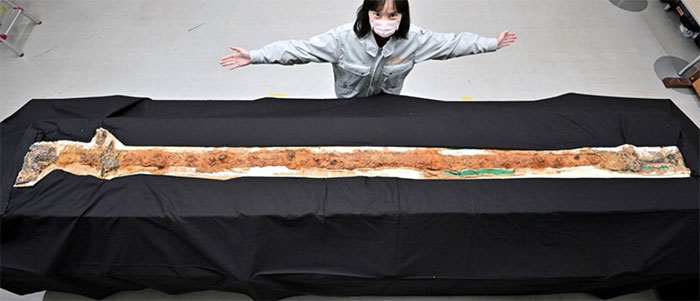Found a giant sword 2.37m long in the ancient capital of Japan
The sword excavated from the Tomiomaruyama Kofun burial mound, Japan, impressed archaeologists with its length and unprecedented design, combining the features of both a single-edged katana and a double-edged sword.

The sword, over 2 meters long, was excavated from the Tomiomaruyama Kofun burial mound. (Photo: Mainichi).
Mainichi newspaper recently reported that on March 26, the Kashihara Institute of Archeology, Nara Prefecture and the Nara City Board of Education officially announced the giant "dako" iron sword excavated from Japan's largest burial mound. in Nara city.
This unprecedented double-edged sword and blade hybrid design item is said to be the origin of the ceremonial blades created under the control of the Yamato Monarchy.
This dako sword is 2.37m long and 6cm wide, the oldest sword in Japan and also the largest iron blade found in East Asia from the Kofun period (about the 3rd to 7th century). It was discovered in December 2022 along with a shield-shaped bronze mirror from an unexcavated burial site at the Tomiomaruyama Kofun burial mound , dating from the late 4th century and measuring 109 m in diameter.
The Archaeological Institute removed dirt from the sword's surface during preservation and carefully examined the artifact.
Because it has been underground since the late 4th century, for more than 1,600 years, the sword holder was no longer in its original form at the time of excavation but was almost completely reconstructed.
It was discovered that this hybrid blade had been bent six times and the total length measured 2.85m with the hilt and scabbard attached. The scabbard is 2.48 meters long, made of Japanese big-leaf magnolia wood.

The sword was heavily rusted after more than 1,600 years underground. (Photo: Mainichi).
Masaki Kanekata, head of the archeology institute, said the recent findings were extremely surprising and an important source of information to clarify the process behind the use of swords in Royal ceremonies . Yamato .
"It's possible that the innovative design of iron blades was experimented with starting from this 4th century sword," said Naohiro Toyoshima, an archeology professor at Nara University who is knowledgeable about ancient swords. It was like a turning point that by the 5th century, the shapes of single and double-edged swords began to be designed differently."
For that reason, Kosaku Okabayashi, deputy director of the Kashihara Institute of Archeology, Nara Province, said that the above discoveries show that the technology of the Kofun period went beyond imagination. And the newly unearthed sword and bronze mirror are masterpieces of metalwork from that period.
The giant dako sword is on public display at the museum, Kashihara Institute of Archeology, Nara Prefecture, until April 7.
- China discovered a 2000-year-old green bronze sword as new
- Detect fragments of 100 ancient swords
- Two theories about the ancient Japanese sword of the giant
- 3 great ancient sword the world's most priceless sword
- Treasure sword is still shiny after 2700 years of Viet Vuong Cau Tien
- The sharp and powerful swords of the Vietnamese people for a while
- The sword earns thousands of years of Viking forms
- The 3,200-year-old sword is intact under rock
- Treasures Viking 1,200 years old revealed under the neck
- China found the sword of the Warring States period
- Discovered a 3,000-year-old sword
- 10 legendary swords in world history
 Discovered an ancient centipede fossil 99 million years old
Discovered an ancient centipede fossil 99 million years old Discovered bat-like dinosaurs in China
Discovered bat-like dinosaurs in China Discovered a 200-year-old bronze cannon of the coast
Discovered a 200-year-old bronze cannon of the coast Discover 305 million-year-old spider fossils
Discover 305 million-year-old spider fossils